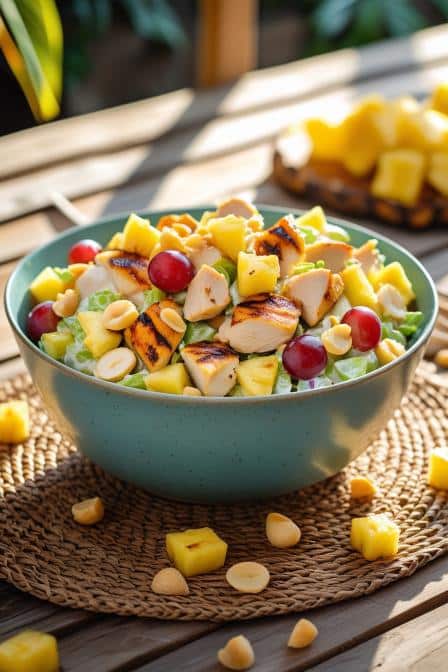Picture this: first time I ever had Hawaiian Chicken Salad, it was at a potluck on a breezy Sunday afternoon in Oahu. Sun beating down gently, laughter bubbling around, and then came this colorful bowl that stopped me mid-sentence. Sweet pineapple, smoky grilled chicken, the faint crunch of toasted macadamia nuts, all tied together by a creamy dressing kissed with tang. One spoonful and I knew—this wasn’t just salad; it was a story on a plate.
That first bite made me question everything I thought I knew about chicken salads. And maybe that’s the secret behind why Hawaiian Chicken Salad isn’t just a salad—it’s an invitation to slow down, breathe in island air, and taste sunshine. Let’s dig deep into what makes this dish tick, how you can perfect it, and why it’s worth mastering in your kitchen.
What Makes Hawaiian Chicken Salad So Special?
At its heart, this isn’t some standard “mix-everything-and-go” dish. The balance of sweet, savory, and creamy is what makes it shine. The tropical twist of pineapple isn’t there just for show—it tenderizes the chicken ever so slightly. Then there’s the textural dance: crunchy celery, buttery macadamias, juicy grapes or mango, sometimes even coconut flakes.
But the true magic? It’s in the dressing. Light mayo or Greek yogurt, a splash of rice vinegar or lime juice, honey for sweetness, and maybe a touch of Dijon for depth. That sauce clings to every chunk of chicken, binding the freshness together. It’s the difference between something you pick at and something you finish before you know it.
And culturally? It’s a delicious nod to Hawaii’s melting pot cuisine: American, Polynesian, and Asian influences mingling together just like the islands’ own history.
Ingredients & Substitutions
Choosing your ingredients carefully changes everything. Here’s a detailed table to keep handy:
| Ingredient | Why it matters | High-quality substitutions or notes |
|---|---|---|
| Cooked chicken (grilled or roasted) | Grilled adds smokiness; roasted stays juicy | Rotisserie chicken for convenience; turkey breast works too |
| Fresh pineapple chunks | Adds sweetness and tenderizes | Canned pineapple (use unsweetened) or mango for a twist |
| Celery, diced | Crunchy counterpoint | Water chestnuts, jicama, or apple for crunch |
| Toasted macadamia nuts | Buttery crunch, signature Hawaiian feel | Cashews, almonds, or pecans |
| Red grapes (halved) | Sweet bursts and color | Diced mango, apple, or dried cranberries |
| Green onions (scallions) | Mild sharpness, freshness | Chives or finely minced red onion |
| Dressing base: mayo or Greek yogurt | Creamy binder, adds tang | Half mayo, half yogurt to lighten; or vegan mayo |
| Honey or brown sugar | Balances acidity | Maple syrup or agave nectar |
| Rice vinegar or lime juice | Fresh acid kick | Apple cider vinegar or lemon juice |
| Dijon mustard (optional) | Adds depth and light heat | Stone-ground mustard or omit |
| Salt & freshly cracked black pepper | Ties flavors together | Adjust to taste |
Ingredient Selection Insights
- Fresh pineapple > canned: enzymes (bromelain) help break down chicken fibers slightly, making every bite juicier.
- Macadamias: toast lightly in a dry pan until golden—they develop an insane depth you don’t get raw.
- Greek yogurt: higher protein, tangier finish; but full-fat is smoother. Don’t skimp.
- Dijon: just half a teaspoon transforms the dressing from flat to “wait, what’s that flavor?”
Step-by-Step Instructions (And a Few Secrets)
1. Prep Your Chicken
Grill or roast chicken breasts. Salt, pepper, a drizzle of oil. Grill until internal temp hits 165°F, let rest, then dice into bite-sized chunks.
Expert tip: Always let it rest at least 5–10 minutes before cutting—keeps juices inside, not on your board.
Common mistake? Overcooking. Chicken should be firm yet springy, not dry.
2. Toast the Nuts
Medium heat, dry pan, 2–4 minutes. Stir often; they burn faster than you think. Cool before adding to salad.
Variation: Add a pinch of cayenne or smoked paprika to nuts for a subtle smoky heat.
3. Chop and Dice
Dice celery and scallions finely. Halve grapes. Cube pineapple. Uniform size makes each bite balanced.
Tip: Drain pineapple on paper towels to prevent watery dressing.
4. Mix Dressing
Whisk together mayo (or yogurt), honey, rice vinegar, Dijon, salt, pepper. Taste, adjust sweetness or acidity.
Too thick? Add a splash of pineapple juice.
5. Combine and Chill
Toss chicken, fruit, nuts, veggies with dressing gently. Don’t mash. Chill for at least 30 minutes. Flavors meld, dressing thickens.
For a spicier kick? Add chili flakes or minced jalapeño.
Cooking Techniques & Science Behind the Salad
Why grill the chicken? Direct heat browns proteins, creating the Maillard reaction—deep, savory notes that roasted or poached chicken just can’t fully match.
Fresh pineapple isn’t just for taste. Its bromelain enzyme gently tenderizes meat if you mix them soon after cooking. But wait until the chicken cools a bit—too hot and the pineapple can make it mushy.
Macadamia nuts? Toasting drives out moisture, condensing flavor and boosting crunch.
The dressing? Acid from vinegar breaks down proteins on the surface, helping sauce cling rather than pool at the bottom.
Storage & Reheating
- Store in airtight container, fridge, up to 3 days.
- Freezing? Not ideal. Pineapple and dressing release water, making salad soggy.
- Leftovers? Great inside a wrap or on toast.
Variations & Substitutions
- Vegan: Chickpeas or tofu instead of chicken; vegan mayo.
- Gluten-free: Naturally gluten-free—just check dressing ingredients.
- Spicy: Add chili flakes, sriracha, or diced jalapeño.
Tools That Help
- Sharp chef’s knife: for even cuts.
- Mixing bowl big enough to toss gently.
- Whisk for smooth dressing.
- Grill or cast-iron skillet for chicken.
Each tool keeps prep smooth and avoids crushing delicate fruit.
Serving & Pairing Suggestions
This isn’t a salad you hide under lettuce. Show it off.
- Serve in a hollowed-out pineapple half—dramatic and perfect for parties.
- Spoon over mixed greens for a lighter meal.
- Pile onto toasted brioche buns or croissants for tropical sandwiches.
Pair it with:
- Coconut rice.
- Chilled Riesling or sparkling water with lime.
- Crisp taro chips or sweet potato fries.
It even plays nicely next to grilled shrimp skewers or cold soba noodles.
Best Time to Serve or Eat
Hot midday summer lunch? Ideal. But it really shines at picnics, beach gatherings, or potlucks. The balance of sweet, creamy, and fresh is unbeatable when the sun’s out.
That said—midweek dinner, Sunday brunch, even meal-prepped lunches? Absolutely. Just keep it chilled until ready.
Conclusion: Why This Salad Deserves a Spot in Your Repertoire
Hawaiian Chicken Salad is more than sweet fruit and chicken. It’s about contrast: smoky grilled meat, juicy fruit, buttery nuts, tangy dressing. Each bite surprises.
Key takeaways?
- Use fresh pineapple.
- Toast those nuts.
- Rest your chicken.
- Balance dressing with acid and sweetness.
Final tip? Don’t rush it. Chill before serving. Like most good things, it gets better with time.
And if you feel creative? Add a dash of curry powder, diced mango, or crispy bacon. It’s your canvas.
FAQs
Can I make Hawaiian Chicken Salad a day ahead?
Absolutely—flavors deepen overnight. Just stir before serving; dressing may separate a bit.
What chicken works best?
Grilled boneless skinless breasts or thighs. Thighs stay juicier; breasts are leaner. Rotisserie chicken saves time.
Can I skip nuts?
Sure. Use toasted coconut flakes for crunch, or seeds if allergic.
How do I keep pineapple from making salad watery?
Drain well on paper towels after cutting. Add pineapple last, right before chilling.
Is this dish freezer-friendly?
Sadly, no. Fresh fruit and creamy dressing don’t thaw well—they turn mushy.
And there you have it—an expert’s dive into Hawaiian Chicken Salad, a dish as sunny as the islands that inspired it. Let each bite remind you: food isn’t just fuel—it’s memory, culture, and a small moment of joy on your fork.

